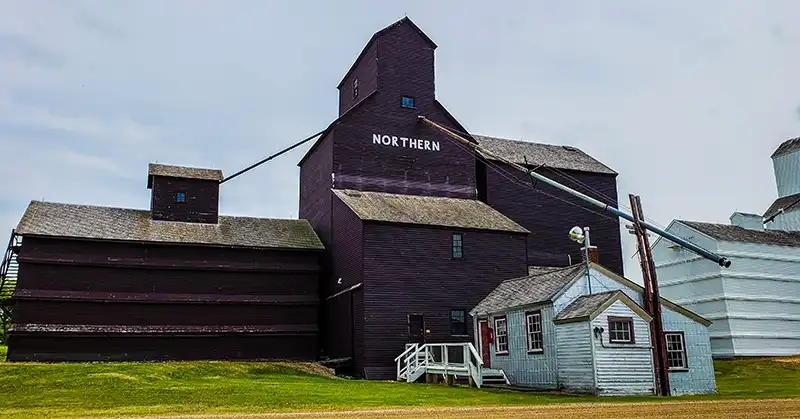
The Inglis Grain Elevators National Historic Site in Inglis, Manitoba, is important to prairie history. Indeed, way back in 1933 there were nearly 6000 elevators on the prairies!
Today, however, you’ll only see few elevators outside of rural museums. That makes sites like Inglis, with its five historic elevators, so significant.
What’s in the Inglis Grain Elevators National Historic Site?
Prairie giants — grain elevators — towered over most prairie towns for a century.
Grain elevators are large bins used to store and transfer various grain crops. The average elevator was square (30 x 30 feet) and 75 feet high, and could hold 30,000 to 40,000 bushels of grain. That’s a lot!

The small town of Inglis was at the end of a rail line that came from nearby Russell, Manitoba. Railway transport, of course, was mandatory for shipping grain. Five grain elevators were built along the Canadian Pacific Railway right-of-way in Inglis, with the first two in 1922.
The Paterson Elevator, owned by the N.M. Paterson company, still stands at the historic site. It operated until 1995 when the CPR discontinued the line. Today, the abandoned train tracks running through the historic site also preserve another part of prairie history that has all but disappeared.
What was the small, square top of an elevator called?
What makes prairie elevators distinctive, though, isn’t just their impressive size and solid structure. It’s the little cupolas that sit on top of the main buildings and look like square heads on top of giant bodies.
If you look closely, you may recognize the cupola as also being on top of castles and forts for lookouts and gun turrets. However, in a grain elevator, they’re where you’ll find conveyor belts (or legs).
These legs carry grain in dozens of small cups or buckets to top chutes leading to the different storage bins.
And while the windows in the “head” of the elevator gave elevator agents a bird’s-eye view on what was happening in town, they had another purpose. They let in light so the elevator agent could work.
Disappearing Grain Elevators
The prairie giants, once icons of the Canadian plains, have all but disappeared, removed by moving trucks and demolition crews.
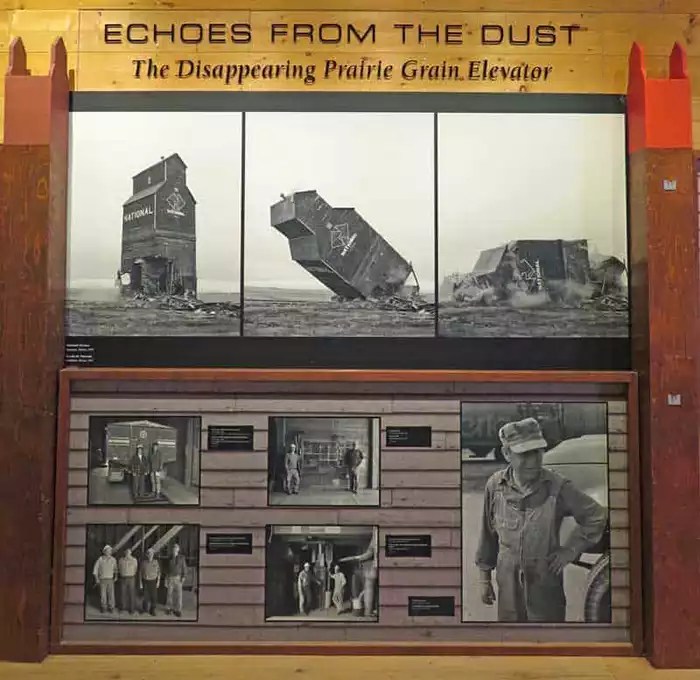
The elevators include:
- Reliance Twin Elevators (the smaller one built in 1922 and the larger one in 1941)
- Northern Elevator Company (1922)
- Matheson-Lindsay Company (1922-23)
- United Grain Growers elevator (1925 elevator replaced one burnt earlier)
All of these were built right after the railroad arrived. Through those years, Inglis was known as the “Barley Capital of Manitoba.”
National Historic Site Designation

Two years after the closure of the Inglis elevators for grain storage and shipment, the row was designated a National Historic Site in Canada.
That was 1997.
The row is intact, standing as it did during the golden era of prairie grain elevators.
An early grain cart shows how the early grain farmers had to transport crops to market.
According to Parks Canada, “The heritage value of Inglis Grain Elevators National Historic Site of Canada lies in its symbolic, visual and substantial representation of a phenomenon typical of the landscape of prairie towns through the early and mid 20th century.”
History of Grain Shipments in Canada
The first grain shipment in Canada happened in 1876 before railroad cars arrived to carry the grain. Instead, ships carried it down the Red River in Manitoba. In those early days of the industry, handling grain was hard work and took a long time. The first elevator in the West was a round one, in Niverville, Manitoba, in 1879. However, the square country elevator design that flourished on the prairies followed quickly, with the first one built in 1881 in Gretna, Manitoba, by Ogilvie Milling Company.
By the turn of the 20th century, train service had arrived. The vast network of grain elevators also began to spring up. In fact, the Canadian Pacific Railway’s policy was to have an elevator built every seven to ten miles along the CPR tracks. The CPR didn’t build them, but offered incentives to grain buyers and companies that would.
Grain elevators and the grain industry thrived for decades. Most towns had one to five elevators and a whole “Railway Avenue,” with the local hotel, bar and cafe all nearby. Of course, everything changes over time and by the 1950s delivery points started to be consolidated. So, rail lines were gradually abandoned along with rural elevators. Then, grain companies built concrete silos designed as high capacity terminals in the 1990s.
Linda’s Pick of the Displays
My favorite part of this historic site — the inside of the elevators.
As a kid, I thought of elevators as being noisy places! They had a steady chug-chug from the motor that ran the conveyor to move the grain to the right bins. Of course, that sound is missing from the historic site.
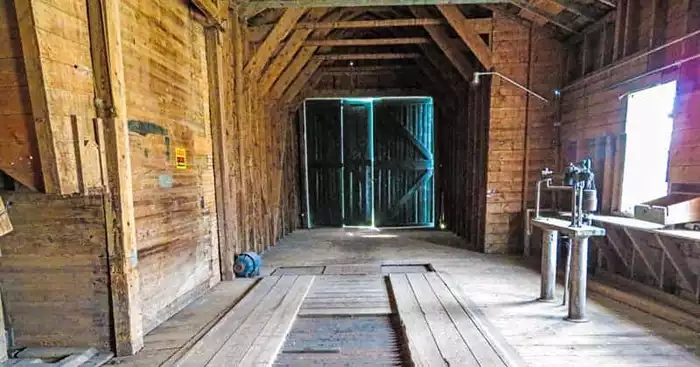
However, if you take a deep breath when you walk in, you’ll likely find, as I did, that you can still smell the grain dust.
As you step carefully over the grates where farmers used to dump their grain, dust on the edges could be chaff. And you don’t have to look too closely to see the elevator’s wooden shaft and chutes worn smooth by years of grain swooshing over the
Everything I remember was still inside the Inglis Grain Elevators. Scales and moisture testers. A tin lunch pail and box of Eddy’s Buffalo matches. The standing scale that weighed the trucks. Even a red wagon from the days before dump trucks.
In fact, the great thing about visiting the Inglis Grain Elevators National Historic Site of Canada is that the interiors look like the agent has just stepped out for a minute.
But now, instead of an agent, there’s a tour guide.
Linda’s Road Trip Tips
David and I stopped in Inglis on a roadtrip to Gimli, Manitoba, to see the Icelandic Festival of Manitoba (which was great fun!). We had a delicious lunch at the Inglis Hotel / Fox and Barrel Pub. My choice: honey garlic chicken flatbread and potato leek soup.
Who Should Visit the Inglis Grain Elevators National Historic Site of Canada?
Of course, everyone should get a close-up look at the grain elevators that contributed so much to Canada’s history! It’s an important place for those working in agriculture to get acquainted (or re-acquainted) with the past.
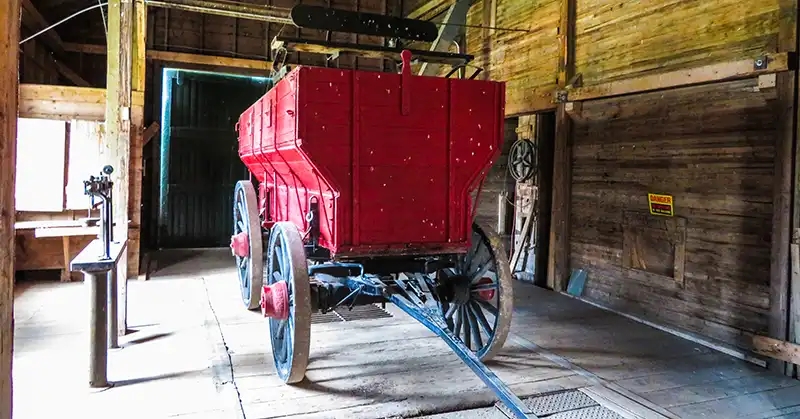
For those unfamiliar with agriculture, the elevators have a treasure-trove of stories and moments to share. The grounds are spacious, so there’s lots of space for young people to explore. And if you have questions, there’s a local guide.
However, you’ll likely not have too many questions!
The Inglis Area Heritage Committee provides great signage to explain how elevators work and what the different parts are called.
There’s even a display of farm implement toys and the Beth Naylor Historic Clothing Collection to see.
How To Visit the Inglis Elevators National Historic Site of Canada?
The elevator interiors are closed in off-season. However, a Visitor’s Centre, situated in the Paterson elevator annex/office, is open from July 1st to the long weekend in September (also open sometimes in June or weekends until Thanksgiving). The day we visited, a young guide was there to answer questions and manage the gift shop.
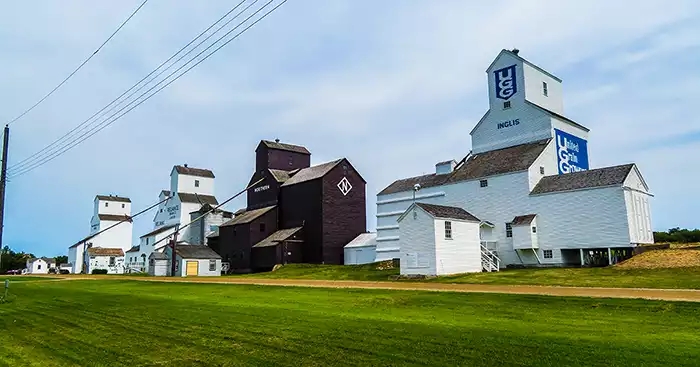
Street Address: Railway Avenue, Inglis MB. Inglis is situated on Provincial Highway 83, north of Russell, Manitoba, on the Yellowhead Highway #16.
On the Web, see: Inglis Elevators Hours of Operation.
Travels With Bill Tours the Inglis Elevators on Youtube.
Driving? Here’s a Google map to help you find it.
Discover More Historic Sites
- Largest Museum Rifle Collection in Western Canada
 Battleford, Saskatchewan, is home to the Fred Light Museum. Its collection includes nearly 400 historic guns from flintlocks to bayonets, along with school and store collections and vintage fire trucks.
Battleford, Saskatchewan, is home to the Fred Light Museum. Its collection includes nearly 400 historic guns from flintlocks to bayonets, along with school and store collections and vintage fire trucks. - Wyoming’s Wild West Frontier Prison Museum
 Prison life in the early 1900s was a matter of survival as you’ll learn when you visit the Wyoming Frontier Prison Museum in Rawlins.
Prison life in the early 1900s was a matter of survival as you’ll learn when you visit the Wyoming Frontier Prison Museum in Rawlins. - Crazy Facts From Toronto’s First Post Office Museum
 Toronto’s First Post Office Museum is in downtown Toronto, Canada. Discover many crazy facts about early postal history in Canada.
Toronto’s First Post Office Museum is in downtown Toronto, Canada. Discover many crazy facts about early postal history in Canada. - Fire the Cannons! BC Historic Bastion
 The Bastion is 36-foot high structure built by the Hudson’s Bay Company in 1853 as a trade fort. The exterior is its original timbers and the interior has been restored to the 1853 – 1862 period.
The Bastion is 36-foot high structure built by the Hudson’s Bay Company in 1853 as a trade fort. The exterior is its original timbers and the interior has been restored to the 1853 – 1862 period. - Dazzling Gold Tiles & More at Hearst Castle
 Visit one of the world’s most luxurious residences — Hearst Castle — in San Simeon, California. With everything from a Roman Pool/bath to 42 bedrooms this spot was a paradise for the rich and famous in the 1920s and 1930s.
Visit one of the world’s most luxurious residences — Hearst Castle — in San Simeon, California. With everything from a Roman Pool/bath to 42 bedrooms this spot was a paradise for the rich and famous in the 1920s and 1930s. - 5 Giant Grain Elevators: National Historic Site
 There are 5 historic, fully-preserved grain elevators at the Inglis Grain Elevators National Historic Site in Inglis, Manitoba, Canada. The interiors are open in some, along with lots of artifacts and signage to explain how they operated.
There are 5 historic, fully-preserved grain elevators at the Inglis Grain Elevators National Historic Site in Inglis, Manitoba, Canada. The interiors are open in some, along with lots of artifacts and signage to explain how they operated. - Stunning Antebellum Era Evergreen Plantation
 The Evergreen Plantation is one of the largest, most intact plantation complexes in the south. It has 37 buildings on the National Register of Historic Places.
The Evergreen Plantation is one of the largest, most intact plantation complexes in the south. It has 37 buildings on the National Register of Historic Places. - Rich Lifestyles in 1880s Saskatchewan – Historic Site
 Discover how young English squires lived, while pioneers were breaking the land, with a visit to Cannington Manor. There’s a small museum as well as restored site buildings.
Discover how young English squires lived, while pioneers were breaking the land, with a visit to Cannington Manor. There’s a small museum as well as restored site buildings. - Fascinating Mystic Seaport Museum: Connecticut
 The Mystic Seaport is a maritime museum dedicated to the history of whaling. Its impressive ship collection includes the Charles W. Morgan last wooden whaleship in the world.
The Mystic Seaport is a maritime museum dedicated to the history of whaling. Its impressive ship collection includes the Charles W. Morgan last wooden whaleship in the world. - Striking Doukhobor Heritage Village: Veregin, SK
 Many Doukhobor people came to Saskatcewan in the early 1900s to escape religious persecution in Russia. Visit their historic settlement in Veregin.
Many Doukhobor people came to Saskatcewan in the early 1900s to escape religious persecution in Russia. Visit their historic settlement in Veregin. - Exposing WWII’s Manhattan Project in WA
 The National Historical Park B Reactor in Hanford, WA, was one of three sites in the Manhattan Project. Take a free tour to see the reactor as it looked during operations.
The National Historical Park B Reactor in Hanford, WA, was one of three sites in the Manhattan Project. Take a free tour to see the reactor as it looked during operations. - Rare 8-Story Tipple at Historical Coal Mine
 Visit an historic Alberta coal mining site operational until 1974 in Drumheller. Lots of fun activities from a train ride to archeology tour.
Visit an historic Alberta coal mining site operational until 1974 in Drumheller. Lots of fun activities from a train ride to archeology tour. - 1800s Giant Bonanza Farm Historic Landmark
 The Bagg Bonanza Farm is a National Historic Landmark in North Dakota. It features a 20-room house and restored barn, along with outbuildings and furniture.
The Bagg Bonanza Farm is a National Historic Landmark in North Dakota. It features a 20-room house and restored barn, along with outbuildings and furniture.
Reference(s)
Facts about the history of grain elevators are from:
- Canadian Encyclopedia
- Walking Tour Information Guide from the Inglis Grain Elevators National Historic Site
- Towers of Silence: The Rise and Fall of the Grain Elevator as a Canadian Symbol by Patricia Vervoort.






